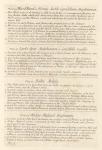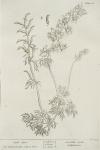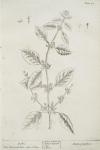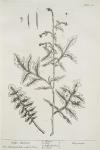

 25. Wood-Bind or Honey-Suckle. Caprifolium or Peryclemenum.
25. Wood-Bind or Honey-Suckle. Caprifolium or Peryclemenum.
1. This Shrub grows to the thickness of eight or ten Inches in circumference, shooting out long slender Stalks, Which twist about every thing they meet with; the Leaves are a bluish green, and the Flowers a pale red; which are succeeded by berries of a deeper red.
2. It grows in most Hedges, and flowers the greatest part of the Summer.
3. The Leaves are sometimes put into Gargarisms for sore Throats. Some commend a Decoction of them for a Cough and the Ptysick; and to open Obstructions of ye Liver & Spleen. the Oil, made by infusion of ye Flowers, is accounted healing & warming, good for the Cramp & Convulsions of ye Nerves. Matthiolus recommends the Leaves & their Juice as good in the Ointments that are used for Wounds in the Head, and Ulcers in the Legs.
4. Greek, Περικλύμενον. Latin, Caprifolium, & Periclemenum. Spanish, Madresilva. Italian, Vincibosco. French, Vincibosse. German, Beissblatt. Dutch, Geytenblad, & Mammetjes-kruyd.

 26. Lark's-Spur. Delphinium, or Consolida regalis.
26. Lark's-Spur. Delphinium, or Consolida regalis.
1. It grows to be a Yard high, the Leaves are a dark Green, and the Flowers commonly a fine blue, but soetimes a Purple.
2. It is sown every Year in Gardens, and flowers most part of the Summer.
3. This is esteemed a vulnerary Plant, of a healing Nature. Matthiolus says it cures the Rheums and Inflammations of the Eyes; mixed with Honey & drank with sweet Wine it removes the sharpness of Urine. It likewise closes up fresh Wounds and heals Ulcers.
4. Greek, Δελφίνιον. Latin, Delphinium or Consolida regalis. Spanish, - . Italian, Consolida reale. French, Pie d'Allouette. German, Rittersporea. Dutch, Riddersporen.
1. This Plant grows to be three Foot high; the Stalks are square, the Leaves a light yellow Green, and the Flowers white.
2. It grows only in Gardens here, and flowers in Iuly and August.
3. The whole Herb is used, and esteemed cordial, cephalic, good for Disorders of the Head and Nerves, hears the Heart, cures its Palpitation, prevents Fainting, Melancholy, Hypochondriac, and Hysteric Disorders; resists Putrefaction, and is of great service in malignant and contagious Distempers; outwardly applied it helps the stinging of Bees and Wasps. The officinal Preparation is, the Simple Water.
4. Greek, Μελισόφυλλον. Latin, Melissa, or Melissophyllum. Spanish, Torongil or Hierva Cidrera. Italian, Melissa. French, Melisse & Pomcirade. German, Melissen Muttercraut. Dutch, Consily de greyn.
Also see #028. Hedge-Mustard. - #029. White Mustard. - #068. Treacle Mustard.
1. It grows to be two Foot high, the Leaves are a yellow Green, & ye Flowers a pale Yellow.
2. Hedge-Mustard grows commonly by Way-sides, and on Banks, and flowers most part of the Summer.
3. This Plant is hot, dry, opens & attenuates; by its warming Quality, it desolves thick and slimy Humours in ye Lungs, helps a Cough and shortness of Breath. It is much recommended against a habitual Hoarsness, to recover ye Voice. Riverius praises a Decoction of it in Wine, as a good remedy for ye Collic. The officinal Preparation is, the Syrupus de Erysimo.
4. Greek, Ερύσιμον. Latin, Erysimum. Spanish, Rinchaon. French, Velar or Tortelle. Italian, Erisimo or Irion. German, Hederich & Wilder-Scuff. Dutch, Steen-Raket.





